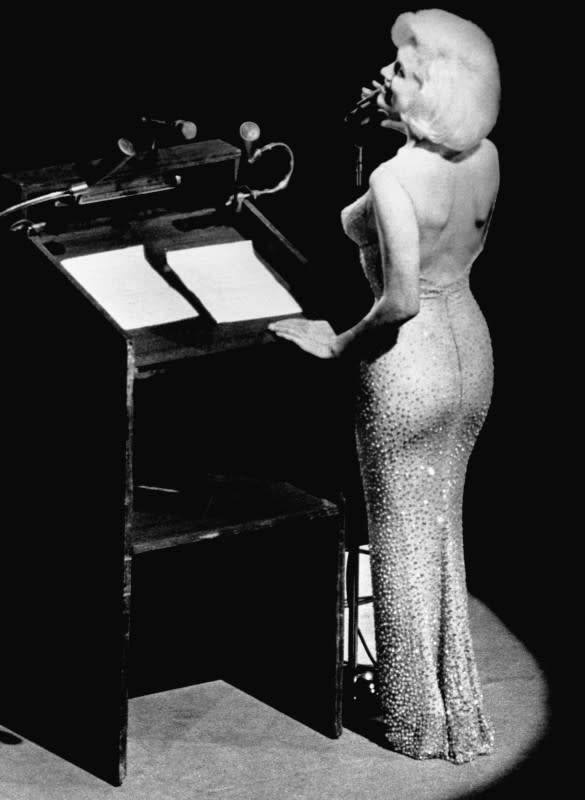How Your Red-Carpet Faves Get Their Hands on Rare Vintage
As one of the most prestigious events in the intersecting worlds of fashion, celebrity and philanthropy, the Met Gala — put on by the Metropolitan Museum of Art's Costume Institute and Vogue every first Monday in May — is a big deal. A huge deal. Each year, culturally-relevant figures, A-List celebrities and, more recently, influencers (TikTok is sponsoring this year's event) take a crack at interpreting a dress code that ties back to the department's spring exhibit. This year, it's "Garden of Time," to correspond with "Sleeping Beauties: Reawakening Fashion," which will bring out 250 items from the permanent collection, chosen for their rarity and arranged according to elemental themes: earth, air and water.
With both the exhibit and the red carpet delving into rare fashion history, the question on everyone's mind is: Who will dare to wear an archival piece?
In the realm of celebrity dressing, pulling from a current runway collection or collaborating on a custom look for an event are both common practices. Sourcing a rare vintage piece has become more popular — though, the process is more opaque. You could work with a vintage boutique owner, to borrow or buy. You could go through a brand that maintains its own in-house archive (as long as you agree to the unique set of rules, procedures and hierarchies). Alternatively, there are private collections and showrooms that deal in loans, sales and auctions.
Celebrities' fashion nostalgia binge could be a good or bad thing, depending who you ask. On the one hand, seeing iconic looks from bygone eras of Dior, Mugler and Versace in motion is always a treat for fashion lovers. On the other, maintaining the integrity of these sometimes-delicate pieces is a valid concern when celebrities decide to wear them out.
This is what set the internet ablaze when Kim Kardashian arrived at the 2022 Met Gala in Marilyn Monroe's iconic 1962 Bob Mackie dress: Despite wearing it for less than 10 minutes, she was accused of damaging the look. In the aftermath, there's (of course) been online discourse around whether these garments should continue to be worn, or are best admired from afar, locked in an archive — to become "Sleeping Beauties," if you will.

Photo: Bettmann/Contributor/Getty Images

Photo: Taylor Hill/Getty Images
Before discussing how these A-listers and their stylists access an archive, it's essential to understand what an archive is. "Fashion archives contain items and garments, either worn or unworn, that are stored in a specific way," explains archivist, professor and author Doris Domoszlai-Lantner. "You need to keep [the garments] safe…they need adequate temperature and humidity control." (Which is to say, these aren't just racks of clothing sitting somewhere in a room, like the sample closet in "The Devil Wears Prada".)
Given the lengths brands go to maintain an archive, which is essentially a tactile and visual history, accessing one is no easy feat. "Some people think that [borrowing] an archival piece is just going directly to the brand," says Nausheen Shah, a stylist and luxury vintage showroom owner. "To be honest, that exchange is very minimal, because brands' archives are super protected."
With the delicate state (and the value) of archival garments, brands are reluctant to loan them out themselves. That's where private collectors and vintage showrooms fill in.
"Most of the archival pieces you see on red carpets are old pieces from buyers — from the '70s, '80s, '90s, who either donated them to museums or sold them to [private] collectors," Shah explains. She herself is an avid collector, and opened The Smoking Archive in 2023, where she trades exclusively in luxury vintage suits by the likes of Balmain and Armani. She works with celebrities, private citizens and movie costume stylists on loans.
"There are a lot of places that [the general public] don't [know] about — very 'if you know you know' — and they choose if they want to have an appointment with you [to loan pieces]," Shah explains, noting that she, too, is very discerning about whom she works with.
It's a game of who you know and who knows you: If you're a stylist, you learn about who owns what through connections or even social media; there are certain shops and showrooms that will extend an invitation to collaborate. "If you're newer [to styling], you have to do some hunting and research, and then you have to build a rapport with those vintage store owners and show them that they can trust you…or else they won't be willing to work with you," Shah says.
As for in-house loans, a brand may employ a principal archivist who makes these decisions, or a dedicated VIP team that handles incoming requests. The criteria for access are still something of a mystery and certainly vary by brand, but they must be universally rigid, as these are often one-of-a-kind pieces.
"You don't want to loan an archival piece to just anyone, because it's valuable and cannot be replicated," says fashion historian Tianni Graham, who works as an archivist at Thom Browne.
Zendaya in Archival Mugler

Photo: Victor VIRGILE/Gamma-Rapho via Getty Images

Photo: Samir Hussein/WireImage
Beyond the monetary value, brands generally only keep one of any given design in their archives, so if it's damaged beyond repair? That's it. That means principal archivists like Graham must be very meticulous with requests: "What's the end product? Where will it be published? Is it worth the money it will take to transport the piece?"
That question brings up another often-unknown facet of the process: Loaning and transporting frangible garments isn't free, and while each brand has its own policy, Graham shares that the costs associated with the loan are often a part of the decision. There's also the issue of liability, i.e., who's responsible if a garment is damaged: "Once it's out of our hands, we have no control over the situation. These are expensive pieces, and we loaned them out in a certain condition."
Shah adds: "Typically, [an archival loan] is the stylist's responsibility. Some people choose not to even take out these expensive pieces because they don't want to be liable."
The length of the loan varies. (It could be just for one night or up to several weeks or months.) Once the garments are returned, they're assessed for damage. If there is damage (hey, accidents happen), the lender may show leniency, depending on the extent. When you start to get into the integrity of the piece, that's when there's a real problem.
"Museums go in and conserve pieces — they'll add tulle or repair a line of beads. But then the question is, once you've done all of these repairs, how original is [the garment] now?" asks Domoszlai-Lantner.
If the garment needs significant altering — think a large amount of beadwork needing to be redone or the full lining needing replacement (which, according to Graham and Shah, is rare) — are they the same piece? Who's to say? Would you ask the same question about the restoration work of a Renoir or Picasso? (But then again, we don't wear Renoirs, do we?)
Unlike a painting that will sit on a wall for all eternity, clothes are designed to be worn — theoretically, at least. And therein lies the conundrum with archival fashion: Should it be preserved or worn as the designer intended?
There's a not-so-secret third option. At this year's Academy Awards, Best Actress nominee Carey Mulligan stunned on the red carpet in a black velveteen 1951 Balenciaga ball gown designed by Cristobal Balenciaga himself…sort of: It was actually a reproduction that she and her stylist, Andrew Mukumal, worked on directly with the brand's famed atelier to recreate perfectly.

Photo: Gilbert Flores/Variety via Getty Images
Natalie Portman went the same route last year at Cannes, referencing the famous Dior Junon dress with a reproduction. More recently, Zendaya and Law Roach paid homage to tennis icons Venus and Serena Williams during the press run for "Challengers" in a replica of the Carolina Herrera dress the sisters wore in a 1998 Vogue shoot.
"Brands may redo a vintage gown just to maintain the integrity of the original," Shah theorizes. "At events like the Oscars or the Met Gala, there's a lot of sweating, food, alcohol… No one wants to risk putting an archival piece through that."
"I think replicas are a safe route," Graham says. "The wearer will be more comfortable knowing that there isn't so much riding on them keeping the piece in pristine condition all night."
Opting for a reproduction also has other obvious benefits: It can be tailored to the wearer's size, and they won't have to worry about returning it at night's end. (Another important piece of this: A brand officially authorizes reproductions, so it has a bit more control over who can do what.) They're a solid compromise between wanting to pay homage to iconic pieces but also wanting to actually wear the pieces. And these beautiful designs deserve to be seen and worn.
We'll all be waiting with bated breath to see who will wear an original, a reproduction or go in a totally different direction at the Met — either way, we'll be at home in our archival sweats.
Want the latest fashion industry news first? Sign up for our daily newsletter.
